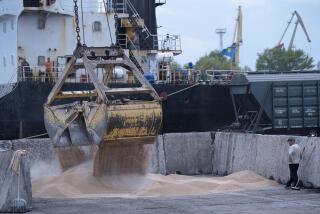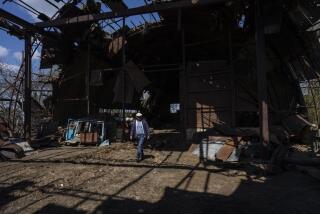Khrushchev’s ‘Fiasco’ Vindicated : Soviet ‘Virgin Land’ Finally Bears Fruit
TSELINOGRAD, Soviet Union — When Nikita S. Khrushchev launched his “virgin lands” program three decades ago, his critics predicted that it would be a fiasco.
It was a high-risk experiment, gambling that massive amounts of money, manpower and machinery would produce substantially more grain despite severe conditions, such as those here in Kazakhstan and elsewhere on the Central Asian steppes.
Khrushchev was later ousted from power and became a non-person in the Soviet Union but Soviet officials now unanimously declare that his virgin lands decision was a triumph of communism.
In fact, according to agricultural planners, another 10 million acres of uncultivated land will be brought into production in the Kazakh Soviet Socialist Republic, as Kazakhstan is formally known, during the next five years. Already, 62 million acres are being cultivated here under the virgin lands program. Here and elsewhere, the program now totals about 89 million acres.
Farming the land is an uphill task. The dry soil must be worked with special plows and drought is an ever-present danger to the harvest. Yields are far below those in such regions as Byelorussia, where grains also are a major crop.
Lack of Reliable Rainfall Hurts
Still, the Soviet government clearly believes the results are worth the risk. Despite the fact that it is hardly an ideal place for farming and lacks North America’s more reliable rainfall, Soviet experts compare it to southern Canada, eastern Montana and the Dakotas.
The virgin lands make sense in a country where grain harvests often are so far below target that crop figures have become a state secret. In 1984, for example, the goal was 240 million tons and the harvest was about 170 millions tons, according to U.S. Department of Agriculture estimates.
“In Kazakhstan alone they’ve got 20 million tons of grain they did not have before,” said an agricultural expert from a Western embassy. “Without it, they would have to import that much grain and pay for it in hard currency. The virgin land crops have become indispensable.”
Nonetheless, the Western analyst expressed surprise that another 10 million acres would be planted to increase grain production. It would be more rewarding, he suggested, to use more fertilizer on existing farmland.
“Kazakhstan gets only one-third as much fertilizer as it should have,” he said, noting that Soviet statistics indicate that 40% of the grain crop gets no fertilizer at all.
Standing on a vast experimental farm near Tselinograd, however, Deputy Research Director Meklis K. Soleumenov said the black topsoil is nearly two feet deep and free of stones.
“If we get a good rain, we get a good crop,” he told a group of correspondents from Moscow.
Soleumenov described how special conservation measures were adopted in Kazakhstan when topsoil began to blow away in a miniature version of the American dust bowl experience of the 1930s.
High grass was planted in strips, between the rows of grain, to hold the moisture from the snow cover that lasts from November to April. To reduce wind erosion, Soviet experts replaced the traditional plow with a wide-bladed model that tills a few inches below the surface without turning over the earth.
Conservation practices, including some copied from Canada and the northwestern United States, have become essential on the 2,120 state farms and 395 collective farms in the Kazakh republic.
At another state farm, about 75 miles from Tselinograd, a prominent signboard quoted V.I. Lenin, the founder of the Soviet state, as saying: “Take care of the earth like the apple of your eye.”
Andrei A. Rimmer, the farm director, presides over wheat fields stretching to the horizon on the 13,000-acre spread.
Standing well over six feet tall and weighing more than 250 pounds, the 59-year-old Rimmer delivers instructions in a booming voice that carries across a large field.
He is one of the million ethnic Germans in Kazakhstan, where his parents arrived in the early part of the century to work the land. About half of his work force is German, with one-quarter Kazakhs and one-quarter Russian.
“No one will fool me in German, Russian or Kazakh (languages) because I understand all that they say,” Rimmer said.
Welcomes Private Farming
While he is devoted to government ownership of farms, Rimmer also welcomed the recent Politburo decision to encourage cultivation of private gardens and keeping of livestock by families for their own profit.
“The more he has in a private plot, the better he is as a (state) farm worker,” he said. A man who owns cattle, he said, would be more willing to work hard to grow fodder that he could feed his animals. In all, 8% of the farm’s production comes from private plots, although they have only a tiny fraction of the land.
Emma Wunder, an ethnic German housewife, said she earns 700 to 800 rubles a year by raising geese, pigs and by keeping a cow to milk. Her family is so prosperous it has its own car--a rarity in the Soviet Union, especially among farm workers.
Rimmer said that average monthly pay is 229 rubles (about $263) on the farm, with bonuses for producing more than the state plan requires.
Farm families are large, averaging four children each, and some have as many as 13 children. The farm has its own movie hall, facilities for dancing and horses for riding, but the nearest major city is a three-hour drive. Television and tape recorders help to fill the recreation gap.
Rimmer, who once worked on a collective farm before he became a state farm director in 1965, said that he prefers the present set-up. On a state farm, he explained, a director gives orders but on a collective farm “we were always voting all the time.”
More to Read
Sign up for Essential California
The most important California stories and recommendations in your inbox every morning.
You may occasionally receive promotional content from the Los Angeles Times.










